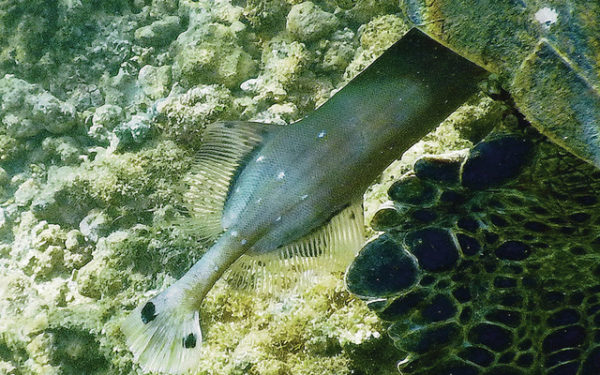Published in the Ocean Watch column, Honolulu Star-Advertiser © Susan Scott
May 16, 2016
While snorkeling last week I thought I saw a remora stuck to the belly of a big turtle.
Remoras are like the family dog standing under the kitchen table waiting for a dropped tidbit, except remoras are lazier. Using the suction cup on top of their heads, remoras, or suckerfish, stick to sharks, dolphins, whales and turtles, getting free food scraps and free rides as well.
 A huge trumpetfish rests near the ocean floor, under a turtle
A huge trumpetfish rests near the ocean floor, under a turtle
that it uses in a kind of symbiosis called commensalism.
©2016 Susan Scott
The fish swimming closely under the turtle, however, was not a remora, but a huge trumpetfish about 30 inches long. But trumpetfish are not scavengers. They’re ambush predators. In cozying up to the turtle, the trumpetfish was hiding from damselfish nibbling algae and parasites off the turtle’s shell and limbs. When one of the damselfish moved to the side of the turtle, whomp! It was gone, sucked into the trumpetfish’s expanding mouth.
Reef fish eating algae and parasites off turtles is a type of symbiosis called mutualism because both the turtle and the fish mutually benefit. One gets food. The other gets cleaned.
Famous examples of mutualism are cleaner wrasses, 4-inch-long territorial fish dressed in flashy yellow, black and purple stripes. The pattern and colors of these little fish are like neon shop signs advertising the wrasse’s service station.
Fish needing parasite removal or wound debriding come to the site and hold still while the wrasse does its work. Sometimes fish without parasites or wounds visit wrasse cleaners, letting them eat body mucus. This might gain favor with the cleaner wrasse for future visits. Or maybe it just feels good.
Wrasses don’t have a monopoly on the cleaning business. At least 111 fish and dozens of shrimp species eat parasites and tend wounds on fish. In appreciation, barracuda, moray eels, snappers and other predators don’t eat their cleaners.
Still, reef fish should trust no one. A couple of sneakers called saber-toothed blennies mimic the colors and behavior of the cleaner wrasses. When a gullible fish approaches, the blenny sinks its teeth in, getting a chunk of fin or body. The ruse works only on youngsters. Older fish know the con and steer clear of the biting blennies.
My turtle and trumpetfish were engaged not in mutualism, but in another kind of symbiosis, called commensalism. In this relationship, one species benefits (trumpetfish), and the other is neither helped nor harmed (turtle).
Before I left the water, I saw the turtle resting near the bottom, her buddy fish positioned so centrally underneath it looked like the turtle had grown a trumpetfish tail. So cute, those two. I love marine biology more every day.